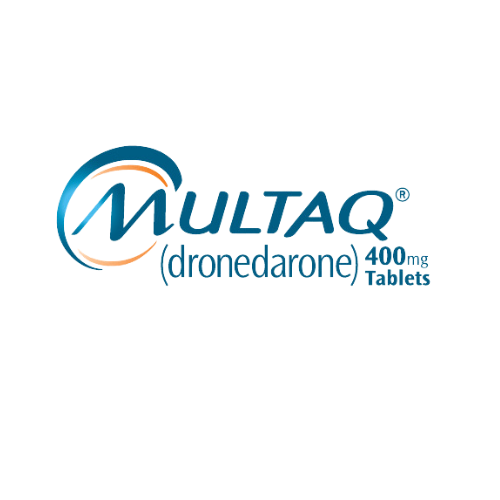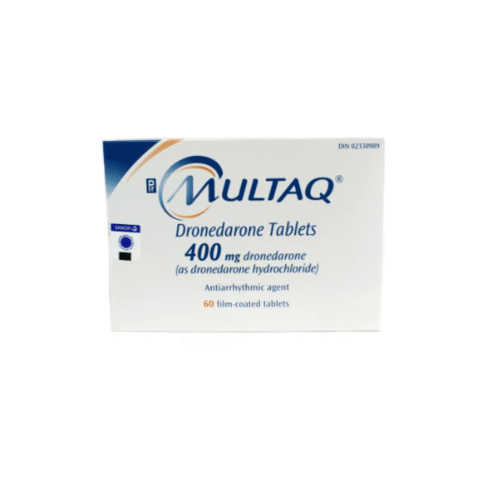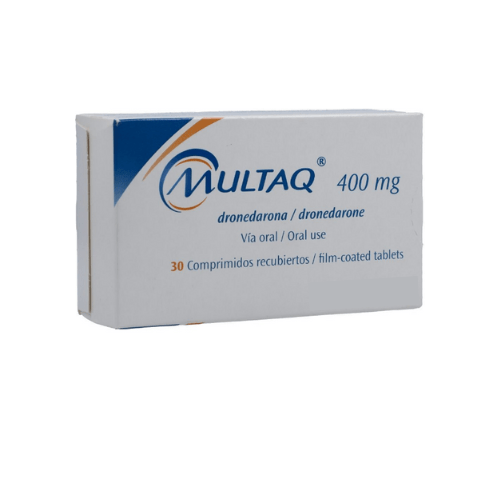Please note: a valid prescription is required for all prescription medication.
Multaq is a prescription antiarrhythmic used to help manage certain types of atrial fibrillation. This page explains what it does, who it may suit, how to take it, and key safety points you should know.
What Multaq Is and How It Works
Multaq® contains dronedarone, a multi-channel cardiac antiarrhythmic. It helps maintain normal heart rhythm and can reduce hospitalizations in adults with paroxysmal or persistent atrial fibrillation who are in normal sinus rhythm. CanadianInsulin.com is a prescription referral platform. We verify prescriptions with your prescriber when required, and licensed Canadian pharmacies dispense your order. If you are comparing access options such as Multaq 400 mg without insurance, we provide US delivery from Canada with clear information on appropriate use.
This medicine acts on several cardiac ion channels and has antiadrenergic effects. These combined actions can slow conduction, help stabilize rhythm, and reduce episodes of irregular heartbeat. It is not an anticoagulant and does not replace blood thinners that may be prescribed to reduce stroke risk.
Who It’s For
The treatment is used in adults with a history of paroxysmal or persistent atrial fibrillation who are currently in sinus rhythm. The goal is to help maintain rhythm and lower the chance of arrhythmia-related hospitalization. Learn more about the condition in our overview of Atrial Fibrillation.
It is not for people with permanent atrial fibrillation. It should not be used in patients with severe heart failure or recent decompensation requiring hospitalization. People with second- or third-degree atrioventricular block, sick sinus syndrome without a pacemaker, bradycardia below 50 bpm, prolonged QTc, or severe liver impairment should avoid it. Your clinician will check your medical history and ECG to determine suitability.
Dosage and Usage
Follow the dose and schedule on your prescription label. The standard approach is one tablet taken twice daily with morning and evening meals. Taking doses with food improves absorption and helps maintain consistent blood levels.
Swallow tablets whole with water. Do not split, crush, or chew unless your prescriber instructs otherwise. Avoid grapefruit or grapefruit juice because it can raise drug levels. Your clinician may check your heart rhythm at regular intervals. If atrial fibrillation becomes permanent, the prescriber may reevaluate continued therapy. For reference-only search terminology, some patients and caregivers may encounter phrases such as Dronedarone hcl tablet 400 mg when reviewing educational materials; always rely on your own prescription for directions.
Strengths and Forms
This medicine is supplied as film-coated oral tablets. Commonly available presentation:
- Multaq 400 mg film-coated tablets
Availability may vary by pharmacy and jurisdiction. Your prescription will specify the tablet count and refills.
Missed Dose and Timing
If you miss a dose, take the next dose at the usual time. Do not double up to make up for a missed tablet. Try to take doses with morning and evening meals to support steady exposure. Set reminders or use a pill organizer to help maintain your routine.
Storage and Travel Basics
Store tablets at room temperature in a dry place, away from moisture and excess heat. Keep the bottle tightly closed and out of reach of children and pets. Do not store in a bathroom cabinet where humidity fluctuates.
When traveling, carry your medication in original packaging with the pharmacy label. Keep it in your carry-on bag to avoid temperature extremes and loss. Bring a copy of your prescription or a medication list for security checks and medical emergencies. If crossing time zones, aim to keep roughly morning and evening dosing with meals; your clinician can provide individualized guidance.
Pen Handling and Sharps Disposal
Tablets do not require pens, needles, or sharps containers. If you have leftover or expired tablets, use a local medication take-back program. If none is available, ask your pharmacist about safe household disposal options. Do not crush tablets to discard, and do not flush unless specifically instructed by local guidance.
Benefits
This treatment can help maintain normal sinus rhythm in appropriate patients with atrial fibrillation. It is taken by mouth and fits into a twice-daily routine with meals. Clinicians may prefer it for selected patients where the benefit of rhythm control outweighs risks. Explore more options within our Cardiovascular category if your care plan involves other heart medications.
Side Effects and Safety
Common effects can include gastrointestinal upset such as diarrhea, nausea, vomiting, or stomach discomfort. Fatigue, rash, pruritus, or mild increases in serum creatinine may occur. Some people notice taste changes or skin reactions.
Serious risks are uncommon but can include liver injury, lung inflammation, and worsening heart failure. The medicine can slow the heart rate and prolong the QT interval, which may lead to dangerous rhythm changes in susceptible people. Seek urgent care for severe dizziness, fainting, shortness of breath, or signs of liver problems such as unusual fatigue, dark urine, or yellowing skin. For educational searching, you may see references to Multaq 400 mg side effects; discuss any concerning symptoms with your clinician promptly.
Drug Interactions and Cautions
This medicine interacts with many drugs. Do not combine with strong CYP3A inhibitors (for example, certain azole antifungals, macrolide antibiotics, or protease inhibitors). Avoid other drugs that can prolong QT or cause torsades de pointes unless your prescriber confirms safety. The treatment can raise levels of digoxin and some statins; your prescriber may adjust monitoring. It can also increase exposure to certain anticoagulants and immunosuppressants.
Anticoagulants are often used in atrial fibrillation to reduce stroke risk. If you take warfarin, your clinic may monitor INR more closely; learn more in our article Warfarin Overview. Direct oral anticoagulants are also used in many patients; see background in Apixaban Uses and practical notes in Eliquis Dosing Tips. Always share a full medication list, including over-the-counter products and supplements. Avoid grapefruit products.
What to Expect Over Time
Your clinician may check your rhythm periodically, often with ECGs. If you remain in sinus rhythm and tolerate therapy, the plan may continue with routine visits. If atrial fibrillation recurs frequently or becomes permanent, your prescriber may revisit options.
Some side effects, such as mild stomach upset, may improve after the first weeks. Report any symptoms of heart failure, such as swelling, rapid weight gain, or worsening shortness of breath. Keep scheduled lab tests and monitoring as directed.
Compare With Alternatives
Care plans for atrial fibrillation often combine rhythm or rate control with stroke prevention. For rate control, a beta‑blocker such as Bisoprolol Zebeta may be used when appropriate. For stroke prevention, a direct oral anticoagulant such as Eliquis may be prescribed based on your clinical risk. These medicines address different goals than the treatment on this page; your clinician selects therapies to match your needs.
Pricing and Access
Many patients compare options online to understand typical cash-pay differences and pharmacy availability. If you are researching Multaq 400 mg price, note that final amounts depend on tablet count, pharmacy, and your prescription details. We show transparent checkout pricing when you proceed to the cart.
We provide Canadian pharmacy pricing with convenient ordering and, when available, US shipping from Canada. If you want to see if any site-wide offers apply, review our current Promotions. Savings vary by product and prescription; taxes and dispensing fees may apply.
Availability and Substitutions
Supply can vary. If an item is temporarily unavailable, your prescriber may recommend a clinically suitable alternative or adjust your care plan. Pharmacists dispense the brand or a therapeutically equivalent option only if your prescription and local regulations permit substitution.
Patient Suitability and Cost-Saving Tips
People with permanent atrial fibrillation or significant heart failure should not use this treatment. Those with certain conduction abnormalities or severe liver disease should also avoid it unless they have a pacemaker or specialist guidance. Regular ECG review helps confirm ongoing suitability.
To manage expenses, ask your clinician whether a 60‑ or 90‑day supply is appropriate, which can reduce per-fill service fees. Set refill reminders to avoid gaps in therapy. For people comparing budgets, searches like Dronedarone 400 mg cost often appear; your pharmacist can explain what affects your out-of-pocket amount. Use one pharmacy for all prescriptions when possible to simplify interaction checks and counseling.
Questions to Ask Your Clinician
- Is rhythm control with this medicine appropriate for my type of atrial fibrillation?
- How will you monitor my heart rhythm and liver function over time?
- Which medicines or supplements should I stop or adjust before starting?
- What symptoms should prompt me to call your office or seek urgent care?
- Can I take this tablet with my current beta‑blocker or calcium channel blocker?
- How should I handle dosing when traveling across time zones?
- Would a multi‑month prescription be suitable for me?
Authoritative Sources
For full prescribing details, see the manufacturer’s site; the US product website provides patient and prescriber information at the official Multaq resource page. The FDA DailyMed database lists current labeling and safety information; search for “dronedarone” at DailyMed labeling and search. Health Canada maintains a database of approved products; you can explore monograph details via the Drug Product Database.
Ready to proceed? You can place your request with prompt, express shipping and temperature-controlled handling when required.
Medical disclaimer: This content is for informational purposes only and is not a substitute for professional medical advice.
Express Shipping - from $25.00
Shipping with this method takes 3-5 days
Prices:
- Dry-Packed Products $25.00
- Cold-Packed Products $35.00
Standard Shipping - $15.00
Shipping with this method takes 5-10 days
Prices:
- Dry-Packed Products $15.00
- Not available for Cold-Packed products
Can I drink grapefruit juice with this medicine?
No. Avoid grapefruit and grapefruit juice because they can raise drug levels and increase the risk of adverse effects.
Do I need routine ECG checks while taking it?
Yes. Your clinician typically checks your heart rhythm at intervals. If atrial fibrillation becomes permanent, they may reconsider therapy.
Is it an anticoagulant or blood thinner?
No. It is an antiarrhythmic. Many patients also require an anticoagulant to reduce stroke risk based on clinical scoring.
What if I miss an evening dose?
Take your next dose at the usual time. Do not double doses. Keep a reminder system to help maintain your schedule.
Which conditions mean I should not take it?
Do not use if you have permanent atrial fibrillation, severe heart failure, certain conduction problems without a pacemaker, markedly prolonged QTc, or severe liver disease.
How should I store the tablets at home?
Keep them in the original bottle at room temperature, dry, and out of reach of children. Avoid heat and humidity.
Can I split or crush the tablets?
No. Swallow tablets whole unless your prescriber specifically instructs otherwise.
Rewards Program
Earn points on birthdays, product orders, reviews, friend referrals, and more! Enjoy your medication at unparalleled discounts while reaping rewards for every step you take with us.
You can read more about rewards here.
POINT VALUE
How to earn points
- 1Create an account and start earning.
- 2Earn points every time you shop or perform certain actions.
- 3Redeem points for exclusive discounts.
You Might Also Like
Related Articles
Sibutramine FDA Ban Explained: Risks, Timeline, Context
Key Takeaways Withdrawal was risk-driven based on higher rates of serious events. Heart and stroke concerns shaped the final regulatory decisions. Not a simple “diet pill” story; outcomes data changed…
Ozempic Eating Disorder Risks and Screening for Safer Care
Key TakeawaysDiscuss ozempic eating disorder concerns before starting appetite-altering medicines.Appetite suppression can help some people, but also trigger restriction.Screening should cover bingeing, purging, laxative misuse, and body image distress.Monitoring matters…
Low Income Medication Help: Steps To Reduce Prescription Costs
Key TakeawaysIf low income medication costs are forcing tough choices, focus on the “next refill” problem first.Start with your exact drug name and strengthCompare cash, insurance, and assistance pathwaysAsk about…
Zepbound storage: Keep It Safe With Clear Temperature Rules
This guide explains Zepbound storage so your medication stays effective. You will learn temperature limits, how long doses can stay unrefrigerated, travel practices, and what to do if a pen…





